
Phytoplankton are microscopic algae that live near the surface of oceans and lakes. Some phytoplankton are motile, which means that they can propel themselves forwards. Like plants, they derive energy from the Sun by photosynthesis and produce more than 50% of oxygen we breathe. The organisms also play a key role in regulating atmospheric carbon dioxide levels.
An algal bloom is created when environmental factors such as nutrient availability and water temperature are favourable for the rapid reproduction of algae. Blooms can be destructive to wildlife, fisheries and tourism by blocking sunlight and by the release of toxic compounds into the water by the algae.
Mixing effect
Blooms can stretch over hundreds of square kilometres of ocean. Tidal currents and winds will often create uneven spatial distributions of algae, resulting in kilometre-sized patches. At length scales shorter than a centimetre, the mixing effect of fluid turbulence was expected to result in a uniform density of microorganisms. However, recent observations surprised scientists by showing that algal blooms have patchy distributions even at the millimetre scale. This patchiness could affect how fast a bloom develops because phytoplankton can reproduce sexually and therefore reproduction rates could be higher in regions of high density.
“The fact that there is a patchy distribution of phytoplankton on a kilometre scale can be easily understood and explained by oceanic currents and strong winds. Nevertheless, at the small scale, hydrodynamics should make things very homogeneous. And yet it doesn’t,” explains Marco Mazza, of Loughborough University.
Mazza and colleagues at Loughborough and the Max Planck Institute for Dynamics and Self-Organization in Göttingen used computer simulations and calculations to explore the origins of this unexpected millimetre-scale patchiness. They have shown that that an interplay between phytoplankton motility and interactions between individual organisms could play a role in creating patchiness on short length scales.
Navier–Stokes equations
The team looked at how motile phytoplankton are affected by hydrodynamic flows. To assess the phytoplankton behaviour on a sub-centimetre scale, the researchers combined 3D particle dynamics simulations with Navier–Stokes equations. The latter are the governing equations of fluid flows and define the relationship between the pressure, temperature, density, and velocity.
“We are solving the full Navier–Stokes equations without any further approximations and coupling this to a particle model describing the position of the particle within the flow, speed and direction of its swimming, it’s orientation, and thermal and biological noise,” Mazza explains, adding “Moreover, we consider the particle-particle interactions”.
Researchers found that the coupling of interactions between individuals to the small-scale flow features strongly favours the creation of dense patches of the organisms.
Prediction tool
These patches have implications to ecology and even human health, as algae will be more likely to mate in dense areas, leading to even faster growth. This research could ultimately contribute to creation of a tool for predicting algal blooms, which would be very useful to those involved in fishing and tourism.
Raymond Goldstein of the University of Cambridge, who was not involved in the work, told Physics World “the general issue is extremely interesting, but I don’t think the researchers have yet explained exactly the mechanism by which the clustering occurs. I do not see a clear physical picture of what exactly the interactions and alignments of cell are that lead to cluster formation. Having said that, this [research] will certainly motivate further investigations, precisely because it raises a nice set of questions and a way to analyse them.”
The research is reported in Proceedings of the National Academy of Sciences.

